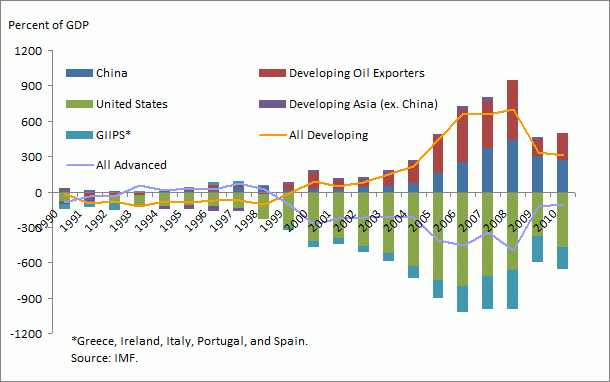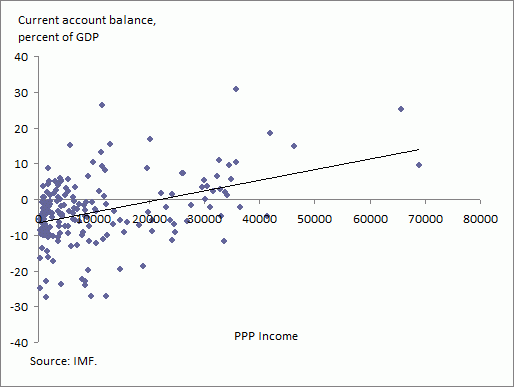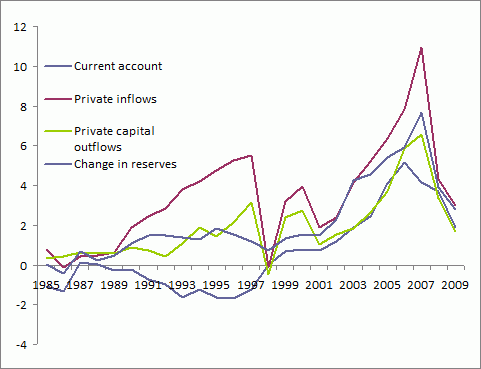The belief that capital should be moving from rich, capital-abundant countries, to poor, capital scarce ones is so widespread that it has practically become a creed (Lucas 1990, Summers 2010, and Wolf 2010).
But this assumption is not only simplistic; it is also dangerous. It can encourage developing countries to attract capital they do not need or cannot absorb. It can also exacerbate international tensions by leading rich countries that run large current-account deficits to believe that their trade deficits are a result of anomalous policies in poor countries, instead of the outcome of their own policies and economic structures.
While concerns about some capital flows may be valid – specifically, excessive accumulation of official reserves in a few emerging markets – the argument that capital should flow from rich to poor countries – often cast in moral or political tones – is not.
Who attracts capital?
Economic theory based on factor endowments (stocks of labour, capital, and other resources) predicts that capital will move from rich, developed countries to poor, developing ones, where labour is relatively abundant and capital should therefore be most productive. This theory is, however, only very imperfectly supported by the facts.
Capital outflows from poor countries frequently outweigh inflows, as reflected in their cumulative current-account surplus.1 Over the decade that preceded the great financial crisis, developing economies saw their cumulative current-account surplus widen, as shown in the chart below. From 2000 to 2009, these countries ran an average current-account surplus of 2.6% of GDP, implying a net outflow of capital to advanced countries, which ran a current-account deficit of 1% of their (much larger) GDP.
Figure 1. Current-account balances
As Figure 1 illustrates, explaining who attracts capital requires more than knowing income levels and factor endowments. The relationship between income and current-account balances across 170 countries over the last 30 years, shown in Figure 2, confirms this. Though the correlation between income and capital outflows is statistically significant and positive, it has weakened in each successive decade. Moreover, incomes explain only a tiny fraction of the variance in current-account balances. Other factors, such as the balance of the government budget, actually explain more.
Figure 2. Income and current-account balance
Why is this so? As widely documented in the economic literature, a number of forces make developing countries less attractive to international investors than factor endowments suggest, while others push capital out of developing countries (Kindleberger 1965, Aliber 1969, Lucas 1990, and Alfaro et al. 2005).
Why (more) capital does not flow to developing countries
First,low incomes are strongly correlated with weaker governance, more burdensome business climates, and less competitive markets – all factors that can reduce marginal returns and discourage investment.2 International investors routinely shun countries with poor or unreliable financial information, unfamiliar regulatory environments, unstable political environments,and poor labour quality (Ahearne et al. 2004 and Alfaro et al. 2005).3
In addition, even if investments are more productive on the margin, their initial costs – including unfamiliar business environments and adapting to new, weaker, and less predictable legal and financial systems – can be much higher in developing countries than in advanced countries (Razin and Sadka 2004). Similarly, capital controls, taxes on inflows, discriminatory tax policies, and exchange-rate controls can also make investment less lucrative. Despite gradual improvements, these remain substantially more common in developing countries than in advanced economies. A recent survey of 182 countries found that, of all countries below the median level of capital-account openness, only one – Iceland – is an advanced economy (Chinn and Ito 2008).
Notwithstanding their relative lack of financial integration, however, as Reinhart and Rogoff (2009) have extensively documented, developing countries are more prone to financial crises and tend to experience greater losses when they occur. These will only become more costly as developing countries grow (Dadush and Shaw 2011a,b).
Furthermore, the history of developing countries defaulting on sovereign debt – in some cases on multiple occasions – makes investing there less appealing. Since 1900, 16 of the 18 countries that have defaulted or restructured multiple times were developing economies (Reinhart and Rogoff 2004). Because devaluation, deep recession, and private defaults nearly always accompany sovereign default, it often spells disaster not just for creditors, but also for foreign investors and business owners (not to mention the country itself).
Finally, Obstfeld and Taylor (2004) argue that a strong desire for safety induces investors to diversify, hedge, and share risk, rather than maximise returns from one particular position. Though this objective will likely lead to some diversification into developing countries, it provides an even stronger incentive to spread capital across sectors and instruments in developed countries, where markets are deeper, more sophisticated, and generally considered safer than those in developing countries.
Why capital flows out of developing countries
In addition to these factors, several forces encourage capital to flow out of developing countries. First, to be a net importer of capital, a country must invest more than it saves. But the savings rates of developing countries are typically higher than those of advanced countries (an average of 28% of GDP from 2000 to 2007, compared to 20%) while investment opportunities are rarer in most cases (Rodrik and Subramanian 2008).4 In other words, capital outflows from developing countries are, in practice, often efficient.
In fact, in 2009, emerging markets, which are home to 46% of global savings, accounted for only 23% of world stock market capitalisation. If investors in developing countries wanted to diversify – just as their advanced economy counterparts do – and allocated funds proportional to the world portfolio of stocks, they would place 77% of their savings in industrial countries. Reflecting the higher savings rate of developing countries, such perfect diversification would imply a net capital outflow of $2.9 trillion annually from developing countries to industrial countries – nearly 5% of world GDP.
Finally, and perhaps most importantly, governments also play a huge role in pushing capital out of developing countries, particularly through reserve accumulation. Capital flows are composed of both public and private flows; as Figure 3 below shows, capital outflows from the public sector – namely reserve accumulation by central banks – have more than offset net private inflows and have also exceeded the cumulative current-account surplus of emerging markets in recent years. Though generalisations about reserve levels should be made with caution, recent accumulation by some countries, beginning with China, appear excessive, even when accounting for the increased uncertainty in the international economy (Dadush and Stancil 2011a, b).
Figure 3. Emerging market balance of payments (% of GDP)
Note: Data prior to 2002 includes HongKong, Israle, Korea, Singapore, and Taiwan.
If all were for the best in the best of all possible worlds
In a world of perfect information, clear property rights, flexible labour and capital markets, homogenous workers, identical savings preferences, and no asymmetric shocks, one would reasonably expect capital to move en masse from advanced to developing countries.
But this world does not exist. Once the various economic factors and complications are considered, it is easy to understand why private capital flows resemble a web of constantly changing, two-way traffic rather than a one-lane, South-bound highway.
Nor is a one-way rush of capital necessarily desirable. Capital inflows into countries with underdeveloped financial systems and weak regulatory capacity can induce excessive lending, speculative bubbles, inflation, currency appreciation, and overinvestment. In numerous cases – including in Latin America in the 1980s and in Asia in the 1990s – onslaughts of capital to developing countries have resulted in extremely costly financial crises (Bailliu 2000, Stiglitz 2004, Reinhart and Rogoff 2004, Kaminsky and Reinhart 1996, and McKinnon and Pill 1997).
This conclusion carries policy implications.
Policy implications
- First, developing countries should not assume they can or should run large current deficits because they are poor.
To be sure, they can benefit greatly from inflows of foreign capital – especially foreign direct investment, which is generally more stable and brings with it know-how – but only if they productively and safely absorb the flows. Correspondingly, capital accounts should be opened with caution.
- Second, the central banks of some developing countries – beginning with China and other countries in Asia – should re-examine their high foreign-reserve levels.
These countries would be well advised to either allow their exchange rates to appreciate gradually and their domestic consumption to rise, or to redeploy their reserves into high-yielding investments, domestic or foreign.
- Third, advanced countries should not assume that large current-account surpluses are natural because they are rich.
Their more favourable investment climates, low household savings rates, and large fiscal deficits, may – and often do – generate the opposite outcome. As in developing countries, the causes of large external imbalances are overwhelmingly domestic.
The IMF, World Bank, and other international financial institutions are by now painfully aware of the dangers associated with overly rapid capital account liberalisation and capital flow surges. Nevertheless, they still too often appear reluctant to spoil the party in times of plenty. With emerging markets accelerating out of the Great Recession, advanced countries lagging, and international interest rates at record lows, this caution is especially pertinent now.
Above all, the global financial crisis has shown beyond a doubt that even the most sophisticated and capable environments have great potential for excess and mistakes when deploying capital. For all of these reasons, economists and policymakers should treat the presumption that large amounts of capital should automatically flow from rich to poor countries with scepticism. The next great financial crisis may well originate in the South, not the North.
References
Ahearne, Alan, William Griever, and Francis Warnock (2004), “Information Costs and Home Bias: An Analysis of US Holdings of Foreign Equities”, Journal of International Economics, 62(2):313-336.
Alfaro, Laura, Sebnem Kalemli-Ozcan, and Vadym Volosovych (2005), “Why Doesn’t Capital Flow from Rich to Poor Countries? An Empirical Investigation”, NBER Working Paper 11901.
Aliber, Robert (1969), “Exchange Risk, Yield Curves, and the Pattern of Capital Flows”, Journal of Finance, 24(2):361-370.
Bailliu, Jeannine N (2000), “Private Capital Flows, Financial Development, and Economic Growth in Developing Countries”, Working Paper 00-15.
Chinn, Menzie D and Hiro Ito (2008), “A New Measure of Financial Openness”, Journal of Comparative Policy Analysis, 10(3):309-322.
Dadush, Uri and William Shaw (2011a), “Juggernaut: How Emerging Markets are Reshaping Globalisation”, Carnegie Endowment for International Peace.
Dadush, Uri and Bennett Stancil (2011b), “Why Are Reserves So Big?”, VoxEU.org, 9 May.
Ju, Jiandong and Shang-Jin Wei (2006), “A Solution to Two Paradoxes of International Capital Flows”, IMF Working Paper 06/178.
Kaminsky, Graciela L and Carmen M Reinhart (1996), “The Twin Crises: The Causes of Banking and Balance-of-Payments Problems”, International Finance Discussion Paper 544
Kindleberger, Charles (1965), “Balance of Payments Deficits and the International Market for Liquidity”, Princeton Essays in International Finance 46.
Lucas, Robert E (1990), “Why Doesn’t Capital Flow from Rich to Poor Countries?”, American Economic Review, 80(2):92-96.
McKinnon, Ronald I and Huw Pill (1997), “Credible Economic Liberalizations and Overborrowing”, American Economic Review, 87(2):189-193.
Obstfeld, Maurice and Alan M Taylor (2004), Global Capital Markets: Integration, Crisis, and Growth, Cambridge University Press.
Razin, Assaf and Efraim Sadka (2004), “Lumpy Setup Costs of Investment: The Lucas Paradox Revisited”, unpublished report, National Bureau of Economic Research, November.
Reinhart, Carmen M and Kenneth S Rogoff (2004), “Serial Default and the ‘Paradox’ of Rich-to-Poor Capital Flows”, American Economic Review, 94(2):53-58.
Reinhart, Carmen M and Kenneth S Rogoff (2009), This Time is Different: Eight Centuries of Financial Folly, Princeton University Press.
Rodrik, Dani and Arvind Subramanian (2008), “Why Did Financial Globalisation Disappoint?”, Working Paper 2008-0143.
Spar, Debora (1998), “Attracting High Technology Investment: Intel’s Costa Rica Plant”, Foreign Investment Advisory Service Occasional Paper 11.
Stiglitz, Joseph (2004), “Capital-Market Liberalization, Globalisation, and the IMF”, Oxford Review of Economic Policy, 20(1):57-71.
Summers, Lawrence H (2010), “A Conversation with Lawrence H. Summers”, interview with Tim Ferguson, Council on Foreign Relations, 17 November.
Wolf, Martin (2010), “How to Fight the Currency Wars with Stubborn China”, Financial Times, 5 October.
1 Since capital flows are notoriously difficult to track and measure accurately in both developed and developing countries, the current-account balance can be used as a proxy. The current-account balance, which is universally and historically available on a comparable basis, equals the sum of the trade balance plus earnings from abroad and net transfers, including aid and remittances. This is the mirror image of the capital account. Current-account deficit countries are capital importers, while current-account surplus countries are capital exporters. This method does, however, aggregate all types of capital flows, which differ in important ways. For example, the motivations behind building a factory or purchasing a large share in a company differ from those behind buying stocks or bonds.
2 Ju and Wei (2006), for example, find that weak property rights can lead to capital outflows, while Spar (1998) notes that a high-profile decision by Intel to invest in Costa Rica was based on primarily on institutional considerations.
3 In his original paper, Lucas stressed the differences in quality of labour, and postulated that high-quality labour could create positive externalities that make capital even more productive than labour-quality adjustments imply.
4 Savings rates are likely affected by a number of factors, including the availability of investment opportunities. However, US savings declined from 20% of GDP around 1980 to below 15% in recent years, while investment rates have stayed relatively constant at 20% of GDP, suggesting the savings rate has declined in response to other factors.






